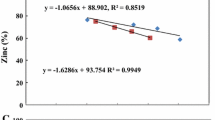Abstract
The practice of sprouting is widely used to improve the nutritional value of grain seeds. Several nutritive factors such as vitamin concentrations and bioavailability of trace elements and minerals increase during germination. The objective of this work was to study the enrichment of various essential trace elements during germination of wheat (Triticum aestivum), buckwheat (Fagopyrum esculentum), and quinoa (Chenopodium quinoa) seeds in order to improve their nutritional role as a source of bioavailable trace elements. Seeds were sprouted either in distilled- or tap-water and in five different electrolyte solutions to investigate the concentration-dependent uptake. The time-dependence was investigated by analyzing aliquots of the sprouts after certain germination periods. Samples were analyzed after freeze drying for their Li, V, Cr, Fe, Mn, Co, Cu, Zn, Sr, Mo, As and Se concentrations with inductively-coupled plasma mass-spectrometry (ICP-MS). As a control for possible changes in the biochemical metabolism of the sprouts, the biosynthesis of vitamin C was also determined by using reversed-phase ion-pair HPLC. It was shown that quinoa was the most resistant to the applied electrolyte solutions and had the highest uptake rates for almost all elements, followed by buckwheat and wheat. Greatest increases were observed for Co, Sr, and Li. No significant changes in vitamin C biosynthesis were observed between sprouts grown in different electrolyte solutions. The time-dependent uptake for most elements was characterized by a significant absorption during soaking of the seeds, followed by a lag phase during the first day of germination and an increased uptake during the second and third day. Se and As showed distinctly different uptake behaviors.
Similar content being viewed by others
References
Kolath W (1986) Die Ordnung unserer Nahrung. Heidelberg: Haug Verlag.
van Koerber KW, Mannle T, Leitzmann C (1983) Vollwert-Ernährung. Heidelberg: Haug Verlag.
Deutsche Gesellschaft fuer Ernährung EV (1987) Vollwert-Ernährung eine Stellungnahme der Deutschen Gesellschaft fuer Ernährung. Ernähr Umsch 9: 308–310.
Meier-Ploeger A (1990) The importance of sprouts and seeds in whole-food nutrition. Ern/Nutr 14: 317–323.
Harmuth-Hoene AE, Bognar AE, Kornemann U, Diehl JF (1987) The influence of germination on the nutritional value of wheat, mung beans and chickpeas. Z Lebensm Unters Forsch 185: 386–393.
Price TV (1988) Seed sprout production for human consumption: A review. Can Inst Food Sci Technol J 21: 57–65.
Colmenares De Ruiz AS, Bressani R (1990) Effect of germination on the chemical composition and nutritive value of amaranth grain. Cereal Chem 67: 519–522.
Vidal-Valverde C, Frias J, Estrella I, Gorospe MJ, Ruiz R, Bacon J (1994) Effect of processing on some antinutritional factors of lentils. J Agric Food Chem 42: 2291–2295.
El-Mahdy AR, Moharram YG, Abou-Samaha OR (1985) Influence of germination on the nutritional quality of lentil seeds. Z Lebensm Unters Forsch 181: 318–320.
Udayasekhara Rao P (1995) Effect of germination on tannin, mineral and trace element composition of groundnut varieties. JAOCS 72: 477–480.
Harmuth-Hoene AE (1987) Dietary fiber and the bioavailability of essential trace elements, a controversial topic. In: Braetter P, Schrammel P (eds), Trace element analytical chemistry in medicine and biology. Berlin: Walter de Gruyter, pp 107–126.
Fretzdorf B (1993) Phytinsaeure in Getreidenährmitteln und Backwaren. AID Verbraucherdienst 38: 3–12.
Oluyemisi Latunde-Dada G (1991) Some physical properties of ten soyabean varieties and effects of processing on iron levels and availability. Food Chem 42: 89–98.
De Wayne Ashmea (1991) Comparative intestinal absorption and subsequent metabolism of metal amino acid chelates and inorganic metal salts. In: Subramanian KS, Iyengar GV, Okamoto K (eds), biological trace element research multidisciplinary perspectives. Washington, DC: American Chemical Society, pp 306–319.
Wolfram S (1995) Intestinale Absorption und Bioverfügbarkeit des Spurenelementes Selen. In: Haas HJ (ed.), Mechanismen des Transports von Mineralstoffen und Spurenelementen. Stuttgart: Wissenschaftliche Verlagsgesellschaft, pp 83–93.
Clausen J, Nielsen SA (1988) Comparison of whole blood selenium values and erythrocyte glutathione peroxidase activities of normal individuals on supplementation with selenate, selenite, L-selenomethionone, and high selenium yeast. Biol Trace Elem Res 15: 125–138.
Uthus EO (1992) Evidence for arsenic essentiality. Environ Geochem Health 14: 55–58.
Nicolson IA, Macrae R, Richardson DP (1984) Comparative assessment of high-performance liquid chromatographic methods for the determination of ascorbic acid and thiamin in foods. Analyst 109: 267–271.
Pfannhauser W (1988) Essentielle Spurenelemente in der Nahrung. Berlin: Springer Verlag.
Sattar A, Mahmood F, Khan S, Neelofar Khan I (1985) Effect of radiation and germination on selected nutrients of corn. Food Chem 17: 183–192.
Laeuchli A (1991) Selenium in plants: Uptake, functions, and environmental toxicity. Bot Acta 106: 455–468.
Cullen WR, Reimer KJ (1989) Arsenic speciation in the environment. Chem Rev 89 713–764.
Sattar A, Durrani SK, Mahmood F, Ahmad A, Khan I (1989) Effect of soaking and germination temperatures on selected nutrients and antinutrients of mungbean. Food Chem 34: 111–120.
Author information
Authors and Affiliations
Corresponding author
Rights and permissions
About this article
Cite this article
Lintschinger, J., Fuchs, N., Moser, H. et al. Uptake of various trace elements during germination of wheat, buckwheat and quinoa. Plant Food Hum Nutr 50, 223–237 (1997). https://doi.org/10.1007/BF02436059
Received:
Accepted:
Issue Date:
DOI: https://doi.org/10.1007/BF02436059




